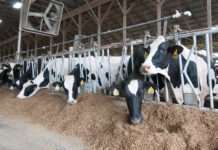K-State experts offer tips on meeting the nutritional needs of young bulls to aid in fertility
MANHATTAN, Kan. — Anyone who has raised a teenage boy knows that meeting his nutritional needs can be challenging because of the rapid growth his body is experiencing.
Just like teenage boys, young bulls also have special nutritional needs to optimize their growth and development, said the experts with the Beef Cattle Institute at Kansas State University on a recent Cattle Chat podcast.
“In developing bulls, it is important to think about the rate of gain and realize that bulls, because of their testosterone, can be fed more than a steer or heifer of the same age,” said Phillip Lancaster, BCI nutritionist.
However, a high-energy diet can cause challenges for the bull’s rumen if not introduced properly, Lancaster said. As one of the chambers in the animal’s stomach, the rumen can experience a pH imbalance leading to acidosis.
“Rumen acidosis is the decrease in rumen pH due to rapid fermentation of carbohydrates,” Lancaster said. In severe cases of acidosis, cattle will show signs of depression, loss of appetite and increased respiration rate.
“Whenever we change feedstuffs, it is important to introduce the new feed slowly over time to allow the bacteria in the rumen to adjust and reduce the risk of acidosis,” said veterinarian Brian Lubbers.
For growing bulls that will be eventually turned out on pasture with cows, Lancaster recommends feeding a high forage diet with some supplementation of feed that offers energy.
“We want to feed developing bulls our highest quality forages and then give them by-products that are high in energy but low in starch such as distillers grains, corn gluten or soybean hulls,” Lancaster said. “These feeds have high energy but because they have little starch, we lessen the risk of acidosis.”
Lancaster and the other veterinarians also said it is important to keep the bulls in the optimum body condition to aid in fertility.
“Producers have a tendency to overfeed developing bulls to make them appear fleshy, but a bull with too much body fat can have fertility issues,” said veterinarian Bob Larson.
He explained: “It is really important for the testicles to be cool, which is why they hang down outside the body, but if there is too much fat deposition at the neck of the scrotum then there can be defects with sperm production.”
Larson said oftentimes when defects appear under a microscope as part of a breeding soundness evaluation that body condition is one of the factors that veterinarians look to as a cause.
“It doesn’t mean that the bulls won’t breed cows, but rather they aren’t as fertile as they could have been,” Larson said.
To hear more of this discussion, listen to the Cattle Chat podcast online.
-30-
FOR PRINT PUBLICATIONS: Links used in this story
BCI Cattle Chat podcast, https://ksubci.org/2021/10/01/is-it-actually-pinkeye-acidosis-and-semen-production-grazing-management-plans-carbon-credits/
K State Research and Extension is a short name for the Kansas State University Agricultural Experiment Station and Cooperative Extension Service, a program designed to generate and distribute useful knowledge for the well being of Kansans. Supported by county, state, federal and private funds, the program has county extension offices, experiment fields, area extension offices and regional research centers statewide. Its headquarters is on the K State campus in Manhattan. For more information, visit www.ksre.ksu.edu. K-State Research and Extension is an equal opportunity provider and employer.
Story by:
Lisa Moser
785-532-2010
[email protected]
More information:
Bob Larson
785-532-4257
[email protected]
Brian Lubbers
785-532-4012
[email protected]
Brad White
785-532-4243
[email protected]




